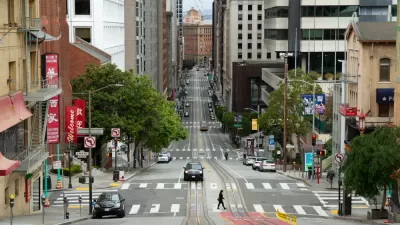Central districts benefit from diversity, but a century of disinvestment and exodus has put many in a precarious position.

The downtown business districts of many American cities, write Emily Badger and Quoctrung Bui in the New York Times, "were created through subtraction." The office buildings we think of as the core of these districts were all that remained after residents, department stores, small retailers, and entertainment venues fled the central city. This "precarious urban monoculture" "was already susceptible to shocks and recessions before the pandemic."
Now, with offices emptier than ever and many remote workers unwilling to return, the future of the central business district has become an urgent question. "Downtowns, like investment portfolios, are more sustainable when they’re diverse. The past year has made that plainly clear in places like Midtown Manhattan, where property tax assessments, transit ridership and small-business revenue fell particularly far during the pandemic."
Yet despite efforts to rebrand urban downtowns as complete neighborhoods suitable for living, working, and playing in, "a century of history" has left many of them hollowed out and dependent on office buildings for their tax base. Cities that have diversified, like Austin, faced less severe economic losses during the pandemic. "The lesson that downtowns need more than offices is 'not just true in this post-Covid world,' said Kourtny Garrett, the head of Downtown Dallas, Inc. 'For us in Dallas, that’s been true since the big crash in the ’80s.'"
FULL STORY: The Downtown Office District Was Vulnerable. Even Before Covid.

Alabama: Trump Terminates Settlements for Black Communities Harmed By Raw Sewage
Trump deemed the landmark civil rights agreement “illegal DEI and environmental justice policy.”

Planetizen Federal Action Tracker
A weekly monitor of how Trump’s orders and actions are impacting planners and planning in America.

The 120 Year Old Tiny Home Villages That Sheltered San Francisco’s Earthquake Refugees
More than a century ago, San Francisco mobilized to house thousands of residents displaced by the 1906 earthquake. Could their strategy offer a model for the present?

In Both Crashes and Crime, Public Transportation is Far Safer than Driving
Contrary to popular assumptions, public transportation has far lower crash and crime rates than automobile travel. For safer communities, improve and encourage transit travel.

Report: Zoning Reforms Should Complement Nashville’s Ambitious Transit Plan
Without reform, restrictive zoning codes will limit the impact of the city’s planned transit expansion and could exclude some of the residents who depend on transit the most.

Judge Orders Release of Frozen IRA, IIJA Funding
The decision is a victory for environmental groups who charged that freezing funds for critical infrastructure and disaster response programs caused “real and irreparable harm” to communities.
Urban Design for Planners 1: Software Tools
This six-course series explores essential urban design concepts using open source software and equips planners with the tools they need to participate fully in the urban design process.
Planning for Universal Design
Learn the tools for implementing Universal Design in planning regulations.
Clanton & Associates, Inc.
Jessamine County Fiscal Court
Institute for Housing and Urban Development Studies (IHS)
City of Grandview
Harvard GSD Executive Education
Toledo-Lucas County Plan Commissions
Salt Lake City
NYU Wagner Graduate School of Public Service




























